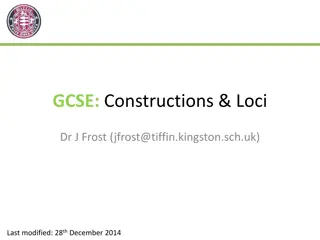Enhancing English Skills: A Comprehensive Guide for GCSE Students
Explore the world of English Language and Literature for GCSE with a focus on analysis, revision techniques, exam structures, and resources for success. Understand the curriculum, assessments, and how to excel in reading, writing, and critical thinking. Find opportunities to boost your grades and achieve academic success in English studies.
Download Presentation

Please find below an Image/Link to download the presentation.
The content on the website is provided AS IS for your information and personal use only. It may not be sold, licensed, or shared on other websites without obtaining consent from the author. Download presentation by click this link. If you encounter any issues during the download, it is possible that the publisher has removed the file from their server.
E N D
Presentation Transcript
Outstanding results 92% Grade 4 and above in English Language 39% Grade 7 and above in English Language 93% Grade 4 and above in English Literature 40% Grade 7 and above English Literature Opening a world of opportunities
What are we studying in English? English Language English Literature Paper 1 50% 1 hour 45 minutes Paper 1 40% 1 hour 45 minutes Shakespeare and the 19th Century Novel Explorations in Creative Reading and Writing. Paper 2 50% 1 hour 45 minutes Paper 2 60% 2 hours 15 minutes Writers Viewpoints and Perspectives. Modern Texts and Poetry Non-examination assessment Spoken Language Opening a world of opportunities
How do the qualifications work? Exam Board- AQA Paper 1 Paper 2 1 hr 45 mins- 50% (80 marks) 1 hr 45 mins- 50% (80 marks) English Language Reading: analyse a piece of unseen literary fiction. Reading: one piece of non- fiction and one piece of literary non-fiction. One piece will be pre 20th century. Writing: descriptive or narrative writing. Writing: writing to present a viewpoint. 1 hr 45 mins 40% (64 marks) Shakespeare and 19th Century Novel 2 hr 15 mins 60% (96 marks) Modern texts and Poetry English Literature Lord of the Flies/ An Inspector Calls Cluster of poems on love and relationships Unseen poetry Romeo and Juliet and A Christmas Carol/ J&H. Opening a world of opportunities
What do I need to know? Content: Both GCSEs will expect students to read and analyse texts from across periods. This ranges from pre-twentieth century to the twenty first century. Assessment: Every half term students will complete a midpoint and final assessment which will provide students with purposeful feedback. They will always be from the exam board. They will build a portfolio of assessments to showcase their progress in order to accurately forecast target grades and final outcomes. This portfolio will form a useful revision resource. Opening a world of opportunities
How can I help? Revision Guides: York Notes; AQA approved revision guides. Mr Bruff on YouTube! Pixl Lit App Parent half-termly newsletter Emailed to all Year 10 parents; Practice exam questions, foci for revision and updates on upcoming units. Sample Exam Papers: Available from the AQA website or from class teachers. Timing: Practise writing for sustained periods of time. Opening a world of opportunities
English Language Paper 1- Structure Student are asked to read the entire source and consider: How has the writer structured the text to interest you as a reader? Opening a world of opportunities
What do we need to look for then? Look for 4 key moments in the text The beginning The next stage Identify a shift in focus/mood/pace etc What next? The ending Opening a world of opportunities
Watch this sequence from Harry Potter and the Goblet of Fire What details does the director draw our attention to in the film? How does the structure of the sequence make it interesting? Opening a world of opportunities
1. Set the scene: darkness; old man alone, vulnerable trigger: the light 2. Caretaker investigates: walks to the house, hears whispers 3. The snake: confirmation of impending danger; caretaker doesn t heed the signs 4. Caretaker gets killed Opening a world of opportunities
Structure of the scene graphic form 1. Which section takes up the most time? Setting the scene - old man in house: 40 seconds Caretaker walks to house and investigates: 80 seconds 2. Why do you think this is? Intro of snake; threat increases - 30 secs 3. Why is the death scene so quick? Death and kettle - 5 secs 4. Why cut back to the kettle? Opening a world of opportunities
Any questions? Opening a world of opportunities
The four key moments 1. The opening What s happening? What s the focus? What s the writer trying to do/show? Does the opening foreshadow anything? What s the effect on the reader? 3. The next stage What s happening? What s the focus? What s the writer trying to do/show? Effect on the reader? Has there been a shift in focus/pace etc? Why has the writer done this? What is the effect of this shift on the reader? 2. The next stage What s happening now? What s the focus now? What s the writer trying to do/show? Effect on the reader? Has there been a shift in focus/pace etc? Why has the writer done this? What is the effect of this shift on the reader? 4. Conclusion What s happening? What is the writer focussing on? Has anything changed? Does the end link back to other parts of the text? Opening a world of opportunities
Some key words to use when discussing structure Opens with /At the beginning foreshadows establishes s viewpoint s perspective Focus on/focus shifts to /focus narrows to An the second half of the extract At this point These two paragraphs juxtapose/contrast/contradict each other Zooms in on Cuts to Shifts Concludes with The ending reminds us of/sums up the idea that Opening a world of opportunities























